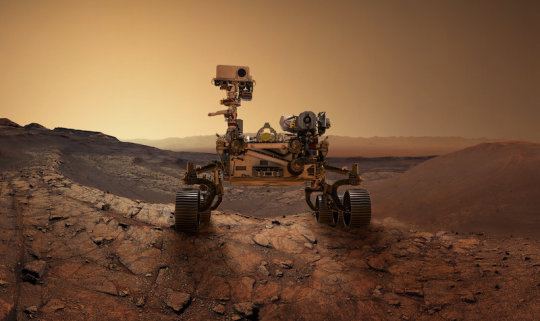MOXIE experiment reliably produces oxygen on Mars
On the red and dusty surface of Mars, nearly 100 million miles from Earth, an instrument the size of a lunchbox is proving it can reliably do the work of a small tree.
在距离地球近1亿英里的火星上,一个饭盒大小的仪器正在证明它可以可靠地完成一棵小树的工作。
The MIT-led Mars Oxygen In-Situ Resource Utilization Experiment, or MOXIE, has been successfully making oxygen from the Red Planet’s carbon-dioxide-rich atmosphere since February 2021, when it touched down on the Martian surface as part of NASA’s Perseverance rover mission.
自2021年2月以来,由麻省理工学院领导的火星氧气就地资源利用实验(MOXIE)一直在成功地从这颗红色星球富含二氧化碳的大气中制造氧气,当时该实验是美国宇航局“毅力”探测器任务的一部分,在火星表面开展。
In a study published in the journal Science Advances, researchers report that, by the end of 2021, MOXIE was able to produce oxygen on seven experimental runs, in a variety of atmospheric conditions, including during the day and night, and through different Martian seasons. In each run, the instrument reached its target of producing six grams of oxygen per hour — about the rate of a modest tree on Earth.
在发表在《科学进展》杂志上的一项研究中,研究人员报告称,到2021年底,MOXIE能够在各种大气条件下进行7次实验,包括在白天和晚上,以及在不同的火星季节产生氧气。在每次运行中,仪器都达到了每小时生产6克氧气的目标——大约是地球上一棵普通树木的产量。
Researchers envision that a scaled-up version of MOXIE could be sent to Mars ahead of a human mission, to continuously produce oxygen at the rate of several hundred trees. At that capacity, the system should generate enough oxygen to both sustain humans once they arrive, and fuel a rocket for returning astronauts back to Earth.
研究人员设想,在人类执行任务之前,MOXIE的放大版可以被送往火星,以几百棵树的速度持续生产氧气。在这种能力下,该系统应能产生足够的氧气,以维持人类到达后的生活,并为宇航员返回地球的火箭提供燃料。
So far, MOXIE’s steady output is a promising first step toward that goal.
到目前为止,MOXIE稳定的产量是朝着这个目标迈出的有希望的第一步。
“We have learned a tremendous amount that will inform future systems at a larger scale,” says Michael Hecht, principal investigator of the MOXIE mission at MIT’s Haystack Observatory.
“我们已经了解到大量信息,这些信息将为未来更大规模的系统提供信息,”麻省理工学院草垛天文台MOXIE任务的首席研究员迈克尔·赫克特说。
MOXIE’s oxygen production on Mars also represents the first demonstration of “in-situ resource utilization,” which is the idea of harvesting and using a planet’s materials (in this case, carbon dioxide on Mars) to make resources (such as oxygen) that would otherwise have to be transported from Earth.
MOXIE在火星上的氧气生产也代表了“原位资源利用”的首次展示,这是一种收集和使用星球上的物质(在这种情况下,是火星上的二氧化碳)来制造资源(如氧气)的想法,否则必须从地球上运输。
“This is the first demonstration of actually using resources on the surface of another planetary body, and transforming them chemically into something that would be useful for a human mission,” says MOXIE deputy principal investigator Jeffrey Hoffman, a professor of the practice in MIT’s Department of Aeronautics and Astronautics. “It’s historic in that sense.”
“这是第一次真正使用另一个行星表面的资源,并将其化学转化为对人类任务有用的东西,”MOXIE副首席研究员杰弗里·霍夫曼说,他是麻省理工学院航空航天系的实践教授。“从这个意义上说,这是历史性的。”
Hoffman and Hecht’s MIT co-authors include MOXIE team members Jason SooHoo, Andrew Liu, Eric Hinterman, Maya Nasr, Shravan Hariharan, and Kyle Horn, along with collaborators from multiple institutions including NASA’s Jet Propulsion Laboratory, which managed MOXIE’s development, flight software, packaging, and testing prior to launch.
霍夫曼和赫克特在麻省理工学院的合著者包括MOXIE团队成员杰森·苏胡、安德鲁·刘、埃里克·辛特曼、玛雅·纳斯尔、Shravan Hariharan和凯尔·霍恩,以及来自多个机构的合作者,包括美国宇航局喷气推进实验室,该实验室负责管理MOXIE的开发、飞行软件、包装和发射前的测试。
Seasonal air
季节性空气
The current version of MOXIE is small by design, in order to fit aboard the Perseverance rover, and is built to run for short periods, starting up and shutting down with each run, depending on the rover’s exploration schedule and mission responsibilities. In contrast, a full-scale oxygen factory would include larger units that would ideally run continuously.
当前版本的MOXIE设计得很小,以适应“毅力”号漫游者,并被建造为短时间运行,每次运行时启动和关闭,这取决于漫游者的探索计划和任务职责。相比之下,一个完整的氧气工厂将包括更大的单元,理想情况下可以连续运行。
Despite the necessary compromises in MOXIE’s current design, the instrument has shown it can reliably and efficiently convert Mars’ atmosphere into pure oxygen. It does so by first drawing the Martian air in through a filter that cleans it of contaminants. The air is then pressurized, and sent through the Solid OXide Electrolyzer (SOXE), an instrument developed and built by OxEon Energy, that electrochemically splits the carbon dioxide-rich air into oxygen ions and carbon monoxide.
尽管MOXIE在目前的设计中做出了必要的妥协,但该仪器已经表明,它可以可靠而有效地将火星大气转化为纯氧。它首先通过过滤器将火星上的空气吸进来,过滤掉空气中的污染物。然后,空气被加压,并通过固体氧化物电解槽(SOXE),这是一种由OxEon能源公司开发和制造的仪器,可以用电化学方法将富含二氧化碳的空气分解为氧离子和一氧化碳。
The oxygen ions are then isolated and recombined to form breathable, molecular oxygen, or O2, which MOXIE then measures for quantity and purity before releasing it harmlessly back into the air, along with carbon monoxide and other atmospheric gases.
然后,氧离子被分离和重组,形成可呼吸的分子氧, MOXIE随后测量氧气的数量和纯度,然后将其与一氧化碳和其他大气气体一起无害地释放到空气中。
Since the rover’s landing in February 2021, MOXIE engineers have started up the instrument seven times throughout the Martian year, each time taking a few hours to warm up, then another hour to make oxygen before powering back down. Each run was scheduled for a different time of day or night, and in different seasons, to see whether MOXIE could accommodate shifts in the planet’s atmospheric conditions.
自2021年2月火星探测器着陆以来,MOXIE的工程师在整个火星年里启动了该仪器7次,每次都要花几个小时预热,然后再花一个小时制造氧气,然后再关闭。每次运行都被安排在不同的昼夜时间,以及不同的季节,以观察MOXIE能否适应地球大气条件的变化。
“The atmosphere of Mars is far more variable than Earth,” Hoffman notes. “The density of the air can vary by a factor of two through the year, and the temperature can vary by 100 degrees. One objective is to show we can run in all seasons.”
霍夫曼指出:“火星的大气比地球的变化要大得多。”“空气的密度在一年中会有两倍的变化,温度会有100度的变化。我们的目标之一是展示我们可以在所有季节跑步。”
So far, MOXIE has shown that it can make oxygen at almost any time of the Martian day and year.
到目前为止,MOXIE已经证明它可以在火星上的任何时间产生氧气。
“The only thing we have not demonstrated is running at dawn or dusk, when the temperature is changing substantially,” Hecht says. “We do have an ace up our sleeve that will let us do that, and once we test that in the lab, we can reach that last milestone to show we can really run any time.”
赫克特说:“我们唯一没有证明的是在黎明或黄昏跑步,这两个时候的温度变化很大。”“我们确实有一张王牌可以让我们做到这一点,一旦我们在实验室进行测试,我们就可以达到最后一个里程碑,表明我们真的可以在任何时间跑步。”
Read more at ScienceDailey.com
更多信息请浏览科技日常











